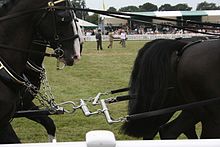Four-in-hand
A four-in-hand or four- in-hand is a tension in which two pairs of horses are tensioned one behind the other.
The two horses on the drawbar run next to each other and are called pole horses , like a pair of horses . The left horse saddle horse , the horse is right hand horse called. A second pair of horses goes in front of the pole horses, the front horses .
In contrast to the four-in-hand horse, four horses are harnessed side by side in a quadriga .
Horses
The two front horses should be brisk, nobler, lighter but not smaller than the pole horses. The pole horses are often of the body type . Heavy warmbloods are often used, such as Old Oldenburgs , Anglo-Normans , Cleveland Bay or Saxon-Thuringian heavy warmbloods .
equipment
For the horses in front, the front scale (also known as the front hanger or front bracket ) is attached to the four-point hook on the drawbar . For driving in a four-in-hand, in addition to a normal two-in-hand line , the pole lines , additional front lines are used for the front horses. On the head frames of the horses in the bar there are leash guides for the leashes of the horses in front. A long four-in-hand whip is used as a whip .
Driving technique
The lines of all four horses are held in the basic position with one hand. Since the four leather lines are usually around 2 cm wide, made of high-quality hide leather, several meters long and fitted with metal buckles , they are heavy and difficult to carry, even when the horses are very light in their mouths. This is why people often ride in the posture in which the right hand grips the lines to support them.
The pole horses must always follow the tracks of the horses in front. As a rule, all four horses should pull evenly. The horses in front must walk forwards without any delay so that their hindquarters do not hit the front scales. However, you must not pull too hard if it is not necessary, as otherwise the cart will hit the horse in the hind legs. When the car rolls along on a level road, the horses in front pull only enough to carry the front scales.
The targeted use of the long four-in-hand whip must be mastered so that the wrong horse, the wrong place or the wrong time is not accidentally hit. Under no circumstances, not even accidentally, should a horse be hit in the head, otherwise it will become head shy. For use by the front horses, the whip is unwound and then raised (wound up) again after use.
use
Four-in-hand horses were used when large, heavy wagons had to be pulled, for example stagecoaches were mostly four-in-hand.
Four-in-hand horses were also a status symbol because the maintenance of four to six horses, which are needed for a four-in-hand, was very time-consuming and expensive. In order to consistently have four operational horse, you have to at least five to six matching horse keeping .
For this reason, and because it is more difficult to drive a four-in-hand than a pair , the four-in-hand competitions are still considered the supreme discipline in driving , for example the FEI World Cup in four- in-hand driving .
Bowling, CHI Geneva , 2013
Web links
Individual evidence
- ^ Driving, Volume 5, Guidelines for Riding and Driving, Deutsche Reiterliche Vereinigung , Warendorf, 1991
- ↑ Die Fahrlehre , Christian Lamparter, Aachen, 1991, chapter Driving with four horses in front of the goat








